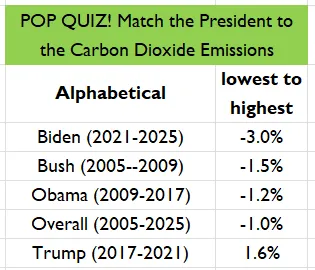Slight, Beneficial Warming From More Carbon Dioxide!
David Wojick | Nov 27, 2020 12:01 AM
Precision research by physicists William Happer and Willem van Wijngaarden has determined that the current levels of atmospheric carbon dioxide and water vapor are “saturated.” In radiation physics that means adding more CO2 or water molecules will bring modest warming that will benefit plant growth, and thus all life on Earth. More CO2 and H2O will not cause dangerous warming. null
From this point forward, emissions from burning fossil fuels will bring little additional global warming, and what does occur will improve forests, grasslands, and agriculture. There is no climate emergency.
This finding is astounding, paradigm-shattering, contrary to what alarmist scientists have told us for decades. Scientifically, it resolves a huge uncertainty that has plagued climate science for over a century: How should saturation be measured, and what is its extent regarding the primary greenhouse gases?
Just as “the greenhouse effect” is nothing akin to how greenhouses work, in radiation physics “saturation” is nothing like the simple, everyday concept of saturation. Your paper towel is saturated when it won’t pick up any more spilled milk. Greenhouse gases are saturated when adding more water, methane, or carbon dioxide molecules has few or no further effects on planetary warming and climate.
Dr. Happer is probably best known as a leading skeptic of “dangerous human-caused climate change.” He co-founded the prestigious CO2 Coalition and served on the National Security Council, advising President Trump. But his career has been as a world-class radiation physicist at Princeton, where Dr. van Wijngaarden teaches and conducts research in pure and applied physics. Happer’s numerous peer-reviewed journal articles have collectively garnered over 12,000 citations by other researchers. null
In their study, Professors Happer and van Wijngaarden (H&W) analyzed saturation physics in painstaking detail. Their preprint, “Dependence of Earth’s Thermal Radiation on Five Most Abundant Greenhouse Gases,” goes far beyond any work done previously on this complex problem.
To begin with, standard studies examine the absorption of solar radiation by greenhouse molecules using crude absorption bands of radiation energy. H&W goes far beyond this, to analyze the millions of distinct energies, called spectral lines, that make up these bands. Their detailed line-by-line approach is an emerging field that often yields dramatically new results – and here contradicts prevailing climate theory.
Moreover, H&W does not look only at absorption. As Dr. Happer explained to me: First, the thermal emission of greenhouse gases is just as important as absorption. Second, how the atmosphere’s temperature varies with altitude is just as important as its concentration of greenhouse gases.
The two physicists, therefore, looked hard, not just at absorption, but also at emissions and atmospheric temperature variation. The work is far more complex than I, most non-physicist scientists, and certainly, most citizens and politicians can understand. However, the conclusions are simple and dramatically clear.
Happer and van Wijngaarden’s central conclusion is this: For the most abundant greenhouse gases, H2O and CO2, the saturation effects are extreme, with per-molecule forcing powers suppressed by four orders of magnitude at standard concentrations. (Forcing power means effects on atmospheric temperature.) null
Their graphs are especially compelling: Figure 9 and Tables 2 and 4 show that, at current concentrations, the forcings from all greenhouse gases are saturated. The saturations of the most abundant greenhouse gases, H2O and CO2, mean the per-molecule forcing is weakened by a factor of 10,000.
The other greenhouse gases analyzed are ozone, nitrous oxide, and methane. These are also nearly saturated, but not as completely as water vapor and carbon dioxide. They are also even less significant components of the atmosphere than CO2 (0.0415% or 415 ppm), which in turn is tiny compared to H2O (3% or less). At just 0.00019% methane truly has a minuscule influence on climate.
The climate science community clearly needs to consider this work very carefully. This may not be easy since three major physics journals have refused to publish it. Their reviews have been defensive and antagonistic, instead of thoughtful, science-based or helpful. Climate alarmism seems to control these journals, and they tend to censor contrary findings. That’s why H&W released the preprint version.
Undaunted, H&W is now extending its analysis to include clouds. Alarmist climate science bases its “dangerous manmade” global warming, not on the CO2 increase alone, but also on incorporating positive water vapor and cloud feedbacks: emphasizing heat-trapping properties of clouds, while largely ignoring the degree to which clouds also block or reflect incoming solar radiation. Because carbon dioxide and water vapor are both saturated, it is highly unlikely that any positive cloud feedbacks can do much damage. However further careful analysis is needed to know this for sure. Stay tuned.


